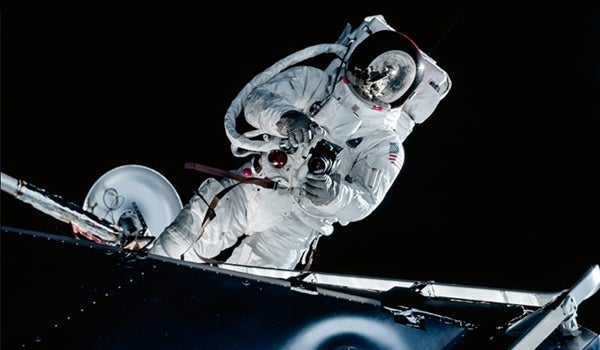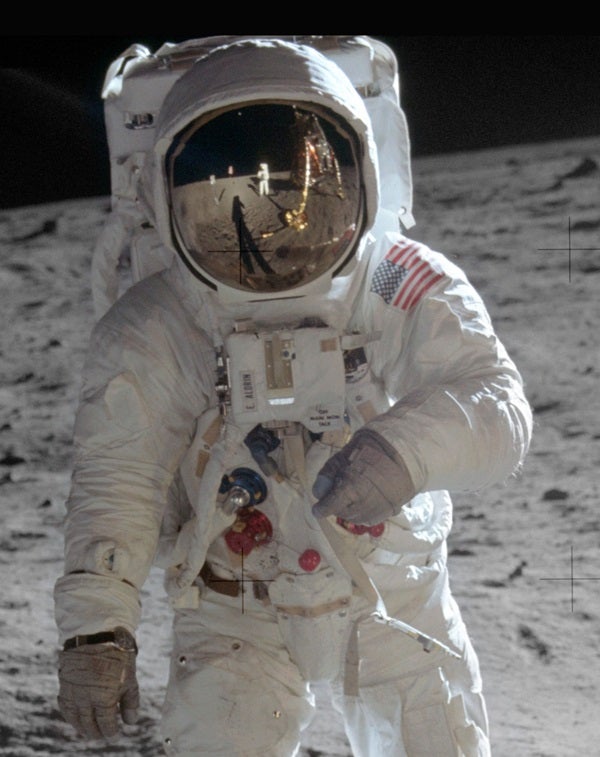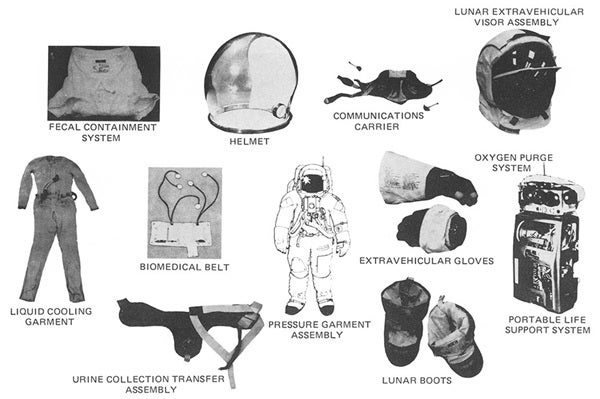Keeping astronauts safe while walking on the Moon was no small task. There’s no air to breathe. Daytime temperatures can reach 250 degrees Fahrenheit. And the scant atmosphere offers no protection from the Sun’s harsh radiation or incoming space rocks. Jagged terrain risked tearing the suit. For Apollo, NASA needed a suit that could shelter astronauts from all these hazards while still being flexible enough for them to bend down to pick up a rock. That means the Apollo lunar spacesuits were the smallest personal spacecraft ever built.
When NASA started looking for contractors to build a spacesuit for its Apollo astronauts in 1962, the business of keeping humans alive in space was still filled with unknowns. But there were a handful of companies with some experience from high altitude aircraft, among them ILC Dover. A branch of the International Latex Corporation best known as the maker of Playtex, ILC Dover had taken its first steps into space suit construction by developing a pressure suit for pilots to wear while flying the X-15 supersonic rocket plane. The suit was built to keep pilots safe from extreme forces without compromising their flexibility. Thus ILC Dover already had a reputation in the burgeoning aerospace industry, enough to earn it an invite to submit a bid to build the Mercury spacesuits in 1959. It lost that bid, but didn’t lose its interest in spacesuits. Almost immediately, ILC engineers started working on the Apollo spacesuit, developing the technology they suspected might meet the space agency’s specific needs. When NASA opened the Apollo suit competition, its bid was ready.
At the time, NASA was looking for what it called a Space Suit Assembly (SSA), something that could be worn during launch and reentry as well as outside the spacecraft. This worked out to be far more than just a suit. NASA wanted a Pressure Garment Assembly (PGA), a Portable Life Support System (PLSS), an Emergency Oxygen System (EOS) as well as whatever was needed to make it capable of supporting Extra-Vehicular Activity (EVA).
ILC’s proposal focused on refining existing technology with an eye on custom designs to suit mission needs. The company handed NASA a full pressure suit that was soft enough to be worn for days at a time yet durable enough to resist abrasion from Moon rocks. For ease of use, it came with detachable boots, gloves, and helmet, as well as a separate life-support backpack; the company boasted that even in a tight space, the suit could be donned by an astronaut without assistance in less than three minutes. NASA liked ILC’s suit but preferred a competitor, Hamilton Standard’s, version of the backpack. And so the space agency awarded a contract that split the work between the two companies.
Not long after beginning work on the suit in earnest, ILC engineers found the lunar spacesuit a bigger challenge than they had initially anticipated. Among the unexpected problems was keeping astronauts safe from themselves. A body at work generates a lot of heat, so ILC had to figure out how to dissipate the heat from inside the suit as well as the heat coming from outside. The solution was a unique set of space age long underwear called the Liquid Cooled Garment (LGC). The nylon-spandex knit formed the breathable structure while polyvinylchloride (PVC) tubes woven firmly into the fabric circulated water that absorbed the astronaut’s body heat. That heat then moved into the backpack where it could be dissipated.
The outer suit was more complicated, and after years of development and testing the A7L version emerged as the multi-layered, multi-pieced garment complete with a backpack assembly ready for its lunar mission.
The main piece was the Torso-Limb Suit Assembly, a single garment that covered everything save but the hands and head. With internal cables for stability and dipped rubber convoluted joints at the shoulders, elbows, wrists, hips, knees, and ankles, it was structurally rigid when pressurized but still gave the astronaut a good range of motion. Permanently attached to this main pressure garment was the Integrated Thermal/Meteoroid Garment (ITMG). Made from five layers of aluminized Mylar, one layer of polyester fiber fabric called Dacron scrim, and one layer of neoprene-coated nylon, all nested to protect against small impacts. The outermost layer was made of woven glass fibers, a material called Beta Cloth that would melt but not burn. For walking on the Moon, the outfit was completed with protective overboots, rubber-finger-tipped and abrasion-resistant gloves, and a set of sun filters worn over helmet faceplate. And, of course, the PLSS backpack.
The Portable Life Support System (PLSS) is what turned the spacesuit into a livable spacecraft. The PLSS housed the s0-called “consumables” that astronauts needed, namely oxygen. Oxygen not only pressurized the suit, it circulated to give them breathable air. But more than just providing oxygen, the PLSS was a fully contained system. As oxygen cycled through the suit, exhaled carbon dioxide was passed into the PLSS where the toxic vapor was removed along with any other particles like exhaled moisture or anything that might have an odor (though all the astronauts said doing anything particularly smelly in the suit was generally ill advised).
Contaminated gas was directed to the contaminant control assembly where it was purified and then sent into the sublimation where heat was released, and excess moisture condensed. That water was separated and sent into a storage reservoir. A fan then forced the recycled air through a backflow check valve and back into the suit where it would go through the same process, as would recycled water pumped back through the LGC.
Of course, there was always the chance for something to go wrong, and there wasn’t exactly a repair shop on the lunar surface. If the PLSS failed, the Oxygen Purge System was the backup. Located atop the main backpack, it provided emergency oxygen, power, and life support giving the astronaut enough time to get back to the safety of the LM.
The last piece of the EVA puzzle was the chest mounted Remote Control Unit (RCU). Mounted on the astronaut’s chest outside the suit, this gave easy access to communications controls as well as some of the suit functions including warning and indicators. As a secondary function, it served as a mounting point for the standard Hasselblad camera astronaut used to take pictures on the surface and the Oxygen Purge System actuator.
Anticipating some catastrophic failure, the Buddy Life Support System (BLSS) gave an astronaut a way to keep his companion safe if something went wrong. Through the BLSS, the functioning suit could provide cooling for both men for 75 minutes, long enough to get back to the LM. Though the buddy system was used in training and went to the Moon on Apollos 14 through 17, it was never used. The PLSS did its job on every surface EVA.
All told, the suit and backpack was a lot of gear that amounted to about 180 pounds on Earth, but in the Moon’s reduced gravity, it was a far more manageable 30 pounds.
Modern astronauts might not be walking on the Moon, but their spacesuits still have to function like wearable spacecraft during spacewalks. Advances in technology in the last half century mean spacesuits today feature more sophisticated electronics, and the construction is different since floating in space isn’t the same as walking on the Moon. The suits are now off-the-rack models rather than custom built for astronauts as they were in Apollo, but the upper and lower body sections as well as the arms and other pieces are interchangeable for a near-custom fit. Nevertheless, the function is the same: give astronauts a little bubble of an Earth-like environment for an out-of-this-world job.












